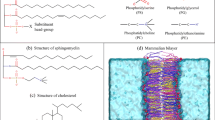Abstract
Surface activity of antiarrhythmic drugs and their effect on lipid-containing interphases were studied. Compound No. 7351 (diethylaminopropyl ester of diphenylisopropylacetic acid), Fubromegan, methyldiazine, propranolol, quinidine, novocainamide, xylocaine, and trimecaine were shown to be surface active. The curves of surface activity and, in particular, of interphase activity and those of antiarrhythmic action follow parallel courses. The most active antiarrhythmic compound (No. 7351) increased the electrical conductivity of a lecithin bilayer membrane much more strongly than novocainamide.
Similar content being viewed by others
Literature Cited
A. É. Grinfel'd and É. V. Narushevichus, in: Biophysics of Membranes [in Russian], Vol. 2, Kaunas (1972), p. 196.
N. T. Pryanishnikova, Dokl. Akad. Nauk SSSR,141, 1228 (1961).
N. T. Pryanishnikova, Farmakol. Toksikol., No. 2, 178 (1970).
N. T. Pryanishnikova, Farmakol. Toksikol., No. 2, 195 (1973).
N. T. Pryanishnikova, A. P. Drozhzhin, and M. M. Fel'dshtein, Farmakol. Toksikol., No. 4, 418 (1974).
N. T. Pryanishnikova and V. A. Pchelin, Dokl. Akad. Nauk SSSR,126, 1358 (1959).
N. T. Pryanishnikova and K. S. Raevskii, Byull. Éksp. Biol. Med., No. 3, 67 (1973).
N. T. Pryanishnikova and P. A. Rebinder, Abstracts of Proceedings of the 7th International Symposium on the Chemistry of Natural Compounds [in Russian], Riga (1970), p. 342.
N. T. Pryanishnikova and G. V. Tolstikova, Dokl. Akad. Nauk SSSR,221, 1229 (1975).
V. M. Samvelyan and M. V. L'vov, Farmakol. Toksikol., No. 3, 309 (1970).
V. M. Samvelyan and L. S. Oganesyan, Izv. Akad. Nauk. SSR, Biol. Nauki, No. 6, 35 (1964).
V. I. Shvets, L. Antal, et al., Zh. Obshch. Khim.34, 1908 (1964).
P. Mueller, D. O. Rudin, et al., Nature,194, 979 (1962).
B. N. Singh and D. E. Jewitt, Drugs,7, 426 (1974).
L. Szekeres and G. J. Papp, Experimental Cardiac Arrhythmias and Antiarrhythmic Drugs, Budapest (1971), p. 287.
Rights and permissions
About this article
Cite this article
Pryanishnikova, N.T., Samvelyan, V.M. & Dyadyura, Z.A. Role of surface phenomena in the mechanism of action of antiarrhythmic drugs. Bull Exp Biol Med 82, 1811–1814 (1976). https://doi.org/10.1007/BF00785703
Received:
Issue Date:
DOI: https://doi.org/10.1007/BF00785703




